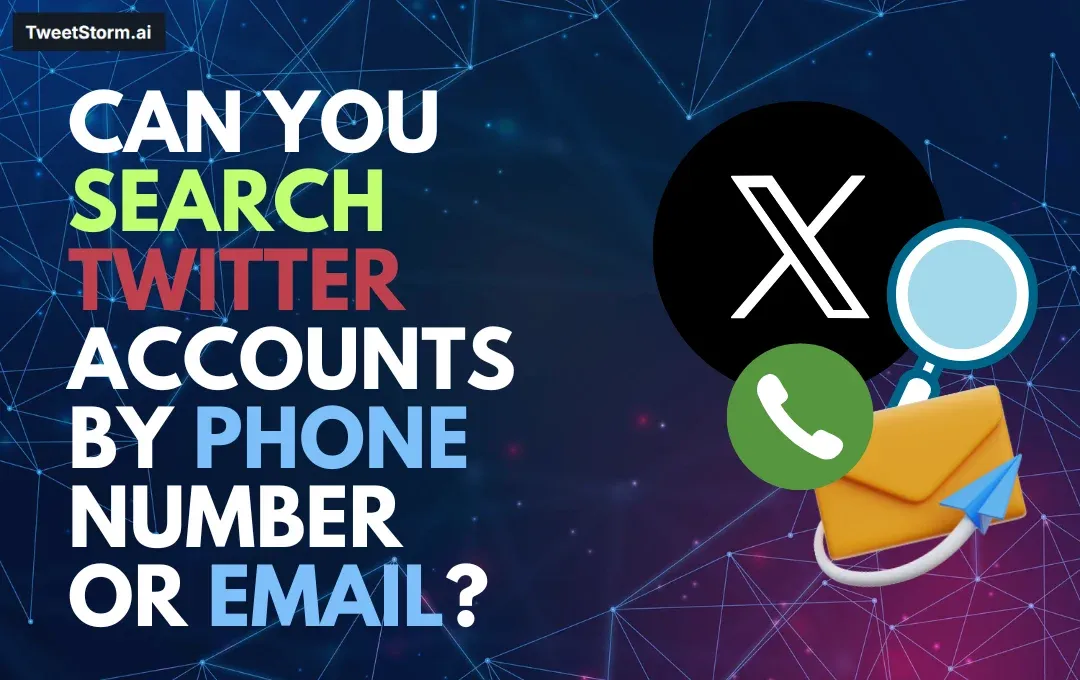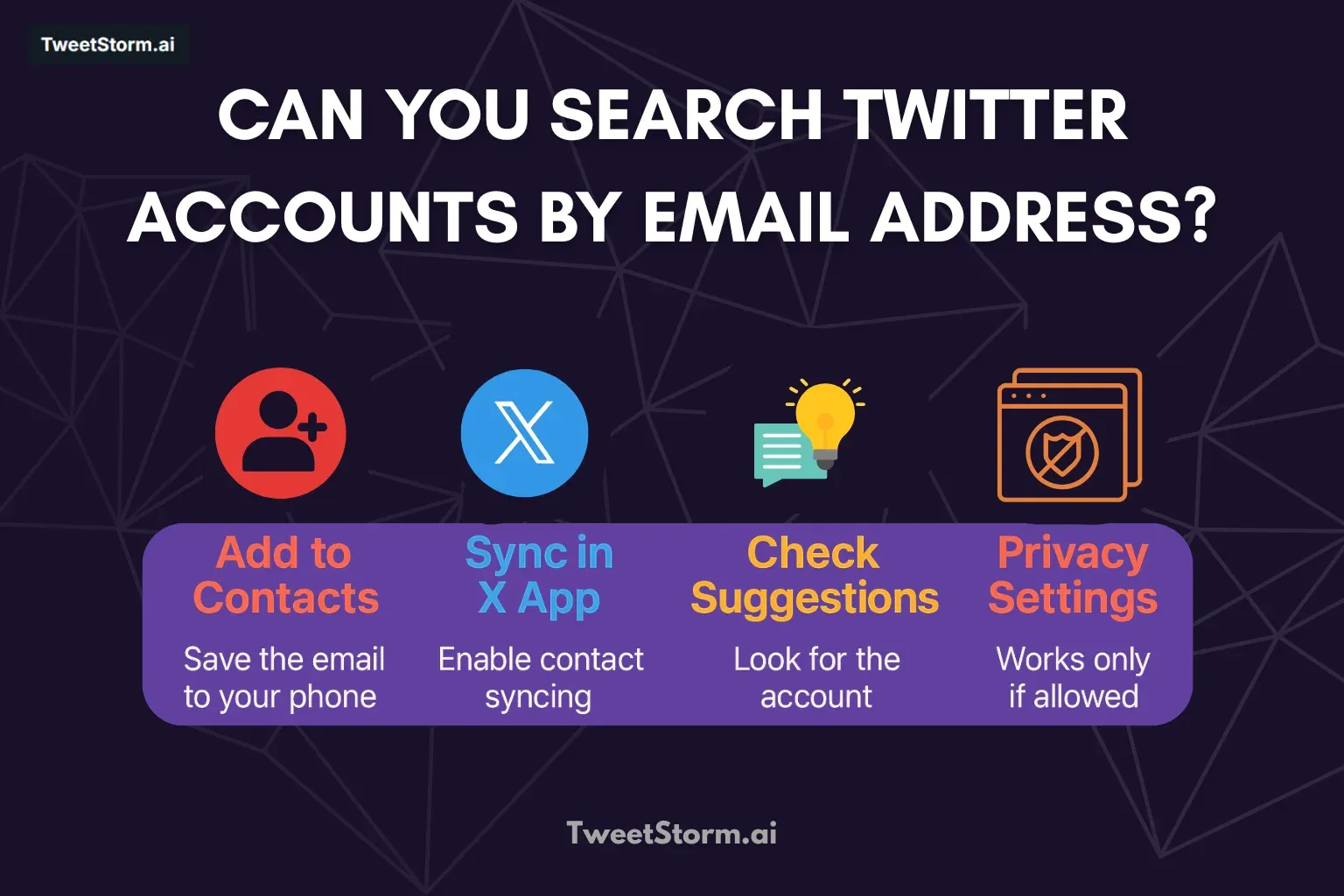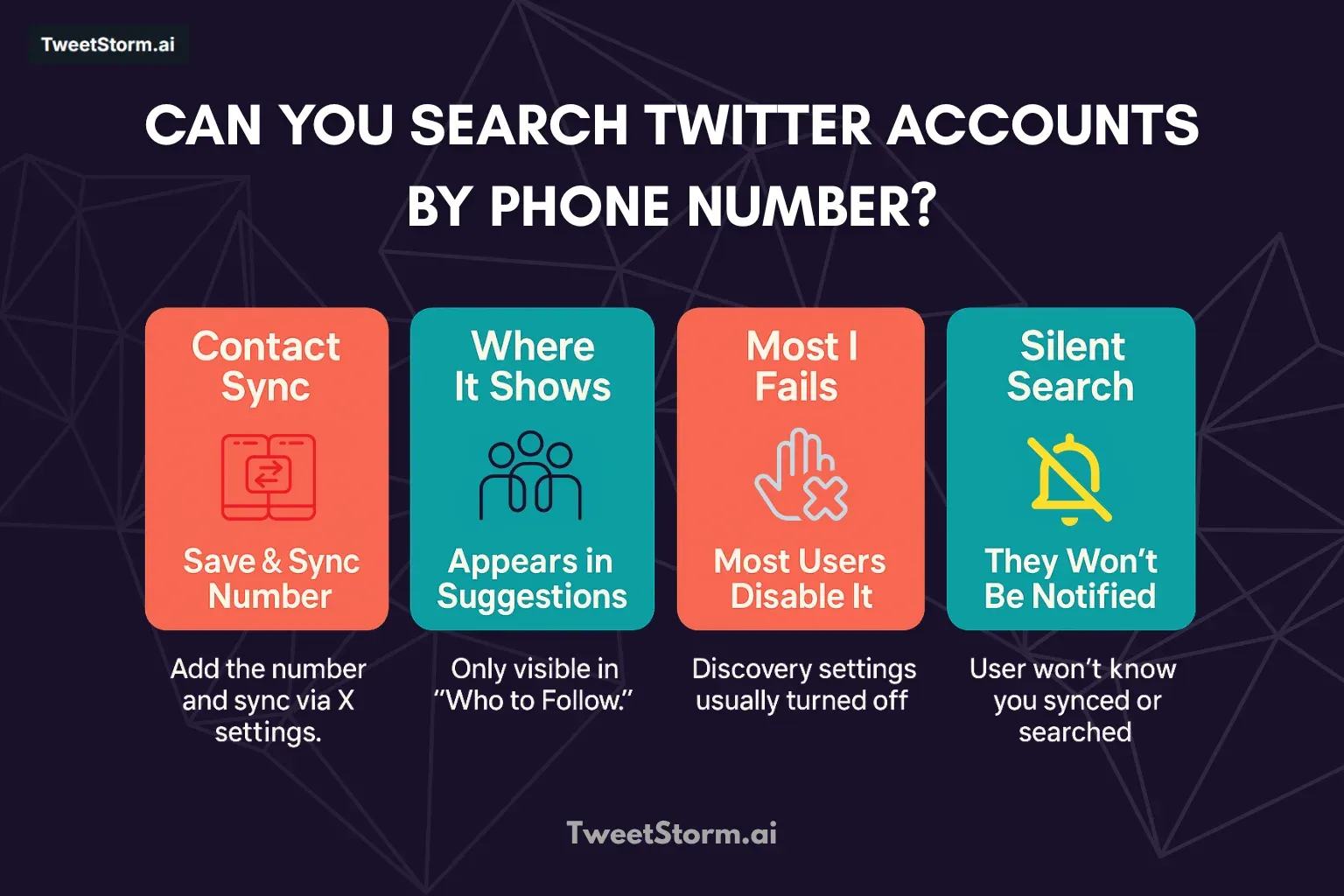Can You Search Twitter Accounts by Phone Number or Email? (Answered)

Hiring managers double-check applicants, journalists verify sources and everyday users try to reconnect with friends who changed their @handle. All of them share the same question: “Can I track down a Twitter (now X) account if all I have is a phone number or an email address?” The short answer is sometimes, but only when the account owner’s privacy settings allow it.
Can You Search Twitter Accounts by Email Address?

Short answer: sometimes, if the person lets X (formerly Twitter) make their account discoverable by email. The feature works almost exactly like phone-number matching, but it lives or dies on the user’s privacy settings.
How Email-Based Discovery Works
- Add the email to your contacts.Put the address in your phone’s address book (or Google Contacts). X only checks emails you’ve already stored.
- Sync contacts in the X app.*Profile icon → * Settings & privacy → Privacy and safety → Discoverability and contacts. Toggle Sync address book contacts to “On.”
- Review “Who to follow” suggestions.After syncing, X will surface any account that’s linked to an email in your contacts and has email discoverability enabled.
An Optional, but Flaky, Work-Around
A few tutorials suggest pasting the email address directly into Twitter’s search bar or Advanced Search. It can work if the user’s address appears in a bio or tweet, but in practice it’s hit-or-miss and usually fails when privacy settings are tight.
Why Email Searches Fail More Often Than You’d Think
- User privacy controls. Anyone can turn off “Let others find you by your email” in the same settings panel. Once that’s off, no amount of contact syncing will reveal their handle.
- Alternate or burner emails. Many people use a secondary address (or none at all) on their X account.
- Shared domains. Common school or company domains can return multiple suggestions, making it hard to pinpoint the right person.
Quick Takeaway
Email discovery is convenient, when it works. If a sync turns up nothing, it’s usually because the user has disabled the feature or attached a different address to their profile. In that case, you’ll need to fall back on username searches, mutual followers or third-party lookup tools (covered later).
Can You Search Twitter Accounts by Phone Number?

If you’re hoping to plug someone’s phone number into Twitter and instantly pull up their profile, it’s not that simple.
Twitter (now X) doesn’t have a public search box for phone numbers. The only way the platform matches numbers to accounts is through contact syncing inside the app and even that depends on the other person’s privacy settings.
Here’s how it works:
- Add the number to your phone’s contacts. Just save it like you would any other contact.
- Sync your contacts with the Twitter app. Inside the app: Profile icon → Settings & privacy → Privacy and safety → Discoverability and contacts → Toggle on “Sync address book contacts.”
- Wait for the app’s “Who to follow” suggestions to refresh. If the account linked to that phone number allows phone-based discovery, it might now appear in your follow recommendations.
Why This Method Fails More Often Than It Works
Most users these days turn off the setting that allows discovery by phone number. If they’ve disabled that toggle, syncing your contacts won’t reveal their account, no matter how many times you refresh.
Also worth noting: Twitter won’t alert the person that you added them or ran a search. This all happens quietly on your side.
Quick Tip
If you’re reaching out for professional reasons (like recruiting or networking), it’s always better to ask for their handle directly or look for it on public platforms where they’ve shared it willingly.
If the phone number route doesn’t work, don’t worry, the next section explains how email discovery works (and its own limitations).
Privacy Settings: How to Stay Hidden
If you’d rather not have your profile pop up when someone syncs their contacts, you can shut the door in seconds. Conversely, if you want friends to find you, just flip the same switches the other way. Everything lives in one panel inside X (Twitter).
Where the Controls Live
- Tap your profile photo in the app.
- Head to Settings & privacy → Privacy and safety → Discoverability and contacts.
- You’ll see two toggles:
- “Let others find you by your email.”
- “Let others find you by your phone.”
Toggles on? Anyone with your number or email in their address book can get a follow suggestion. Toggles off? You vanish from contact-based searches, simple as that.
What Happens After You Flip the Switch
- Off → On: Friends who sync their contacts may see a “Suggested user” card with your handle the next time they open the app.
- On → Off: Your handle disappears from new contact suggestions almost immediately. (Old suggestions might linger until Twitter refreshes its cache.)
- Data already synced: If someone synced their address book before you disabled discoverability, your account can still live in their cached suggestions. Removing it requires them to clear and resync contacts.
Quick Tip for Students & Professionals
If you’re job-hunting or collaborating on class projects, consider leaving email discoverability on and phone discoverability off. Most recruiters or classmates will have your email, not your personal number, giving you a layer of control without going fully invisible.
Third-Party Lookup Tools, Helpful or Just Hype?
Ever plugged a phone number into Google and watched a wall of “background-check” ads pop up? Those ads lead to services such as BeenVerified, Intelius or Social Catfish, sites that promise to unmask every social profile tied to that contact detail.
Sometimes they nail it: the report shows an old Twitter handle you would have forgotten about, plus a dusty LinkedIn page from college. Other times the match is wildly off, my number apparently belongs to a guy in another state who drives a forklift.
Why people use them
- Convenience. One search, lots of platforms.
- Cross-checking. Helpful if a Twitter handle is buried behind a nickname or burner account.
- Historical crumbs. They can surface deleted or renamed profiles that plain Twitter search won’t show.
Where they stumble
- Accuracy roulette. Recycled phone numbers and shared family emails confuse the algorithms.
- Paywalls everywhere. You get a teaser result, then the “unlock” button asks for a monthly fee.
- Privacy gray zone. These sites scrape huge databases. Depending on where you live, viewing or worse, sharing, someone else’s info could breach local laws.
Quick sanity check
If a lookup tool claims it can “guarantee” the right Twitter account, take that with a grain of salt. Always verify manually, profile photo, bio clues, tweet history, before assuming the report nailed the right person. And, of course, use the intel ethically. Nobody likes a creeper.
Limits, Laws and the “Should I Really Do This?” Test
Let’s get one thing straight: finding a public Twitter profile is legal. But scraping or sharing private data isn’t. Here’s where the line sits.
1. Twitter’s own rules
X’s Terms of Service forbid automated scraping of personal info. Fire up a bot that harvests emails and you risk an IP ban or a polite lawyer-gram.
2. Privacy regulations
In the EU, the GDPR treats phone numbers and emails as personal data. California’s CCPA does the same. Misusing that data, even “just doing research”, can trigger fines.
3. Accuracy pitfalls
Data brokers aren’t perfect. A recycled phone number might tag the wrong Twitter user and an email shared by roommates can point to multiple profiles. One false positive can sink a project or, worse, smear the wrong person’s reputation.
4. Ethical OSINT
Open-source intelligence pros follow a simple playbook:
- Collect only what you need.
- Verify in multiple places.
- When in doubt, ask permission.
It’s boring, until you’re the one facing a takedown notice for publishing someone’s private handle.
5. A quick gut check
If the method you’re about to use feels sneaky, picture explaining it to your professor, boss or mom. If you’d squirm, rethink the approach.
Bottom line
Technical tricks exist, third-party tools abound, but none of them override a user’s privacy settings or the law. Search thoughtfully, double-check every lead and keep your conscience (and coursework) clean.
Need More Than a Contact Sync? Try a Handle-First Deep Dive
If phone- or email-based discovery hits a dead end but you’ve picked up a possible @handle or even a keyword from a friend, switch to a visual dashboard like TweetStormAI. Open its Advanced Tweet Search, write into the search box, add a date window or minimum-likes slider and you’ll see every public tweet that fits. You can even save the setup under “My Tweet Searches” so next time it’s a single click. It won’t reveal private accounts, but once you have a public alias, TweetStorm makes sorting and revisiting that person’s timeline much faster than scrolling Twitter’s default feed.
Final Thoughts:
Finding a Twitter account with nothing but a phone number or email is hit-or-miss by design, that’s privacy doing its job. When the sync trick works, great; when it doesn’t, respect the settings and look for public clues instead. Once you do uncover a handle or keyword, built-in Twitter filters (or a one-screen helper like TweetStormAI) let you explore that user’s tweets without memorising commands.
Bottom line: check the discoverability toggles, verify every lead and keep both ethics and local laws in view. The smartest search is the one that balances curiosity with respect for privacy.
FAQs
1. Does Twitter have a built-in phone-or-email search box?
No. Public search covers @handles, names and keywords only. Phone/email matching works through contact syncing inside the app.
2. Why can I find some friends by phone but not others?
It depends on whether they’ve enabled “Let others find you by your phone” in Settings → Privacy and safety → Discoverability and contacts.
3. Will Twitter notify someone that I searched for them?
No. Syncing contacts or running a search never alerts the other person.
4. Do people-search sites always nail the right Twitter handle?
Accuracy is mixed. Paid tools like BeenVerified or Intelius sometimes mis-match recycled numbers or shared emails, so manual verification is a must.
5. Is reverse-looking someone's phone number legal?
Generally, yes for public data, but sharing or monetising personal info can clash with GDPR, CCPA or Twitter’s own rules. When uncertain, get consent.
6. How do I stop strangers from finding my account by email?
Toggle off “Let others find you by your email” (and phone, if desired) in Discoverability settings.
7. Can I delete contacts Twitter already stored?
Yes. In the same Discoverability panel, tap Remove all contacts to wipe synced address-book data from Twitter’s servers.
8. Why won’t Advanced Search locate an email I saw in a bio?
The email might appear as plain text, but unless it’s linked in account settings, Twitter’s algorithm won’t connect it to that profile.
9. Are there truly free alternatives to paid lookup sites?
Try Google dorks such as "[email protected]" site:twitter.com or "555-123-4567" site:twitter.com. Success varies but costs nothing.
10. Could these methods change?
Absolutely. X (Twitter) tweaks privacy features regularly. Revisit the Help Center before banking on any specific trick.